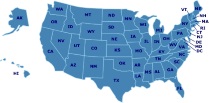Native Americans
Things to See & Do in Missouri
Lewis & Clark National Historic Trail
In 1804, Meriwether Lewis & William Clark began a voyage of discovery with 45 men, a keelboat, two pirogues,and a dog. They departed from Camp Wood located in what was to become Illinois. They traveled over a three-year period through lands that later became 11 states. Most of the trail follows the Missouri & Columbia Rivers. Much has changed in 200 years but trail portions remain intact. At 3700 miles, Lewis & Clark NHT is the second longest of the 23 National Scenic & National Historic Trails. It begins at Hartford, IL & passes through portions of MO, KS, IA, NE, SD, ND, MT, ID, OR, & WA. Many people follow the trail by auto; others find adventure in the sections that encourage boating, biking, or hiking. You can still see the White Cliffs in Montana as Lewis & Clark did. You may stand where they stood looking over the rolling plains at Spirit Mound in South Dakota. You might meet the descendants of the people who hosted Lewis & Clark all along the trail. It remains for your discovery.
Trail of Tears National Historic Trail
The Trail of Tears National Historic Trail commemorates the removal of the Cherokee and the paths that 17 Cherokee detachments followed westward. Today the trail encompasses about 2,200 miles of land and water routes, and traverses portions of nine states.
Featured Resources
As an Amazon Associate, we earn from qualifying purchases. We get commissions for purchases made through links on this site.
Guerrilla Learning: How to Give Your Kids a Real Education With or Without School
If you’ve ever felt that your child wasn’t flourishing in school or simply needs something the experts aren’t supplying, you’re ready to become a "guerrilla educator." this books explains what’s wrong (and what’s useful) about our traditional schools and shows you how to take charge of your family’s education to raise thinking, creative young people despite the constraints of traditional schooling. Filled with fun and exciting exercises and projects to do with children of all ages, this rem...
Raising Topsy-Turvy Kids: Successfully Parenting Your Visual-Spatial Child
Understanding how children learn best allows you to meet their needs and help them succeed. A visual-spatial learner remembers things in pictures and learns better with visual clues and strategies. This book addresses those needs and helps you figure out how to encourage this type of learner in your homeschool environment.
Upside-Down Brilliance: The Visual Spatial Learner
Dr. Linda Silverman coined the term "visual-spatial learner" to describe the special and unique gifts of people who learn best through seeing and with images. This guide is a great resource as you support your homeschooling visual learner in discovering the best ways to learn and succeed.
I Learn Better by Teaching Myself/Still Teaching Ourselves
Take a look at how a homeschooling mother learned to trust her children-and herself-to learn in new ways. Tag along on the journey from the elementary years through high school as this book explore the success and freedom of unstructured learning. These books are especially good for anyone wrestling with the question of "how much structure should there be in a homeschool?"
A Reason For® Handwriting
A Reason For® Handwriting provides a fun, meaningful approach to developing effective handwriting skills. Each lesson is built around a Scripture verse chosen not only for proper letter combinations, but also inspirational content. “Border Sheets” encourage students to share God's Word with others. You'll find product information about A Reason For® Handwriting here.




